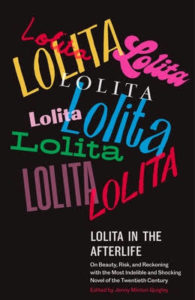
How Would the Publishing World Respond to Lolita Today?
Jenny Minton Quigley on the Novel Her Father Published
I’d guess most people remember reading Lolita for the first time. I do.
Freshman fall in college. It was 1989 and I had just turned 18. I curled up under my Laura Ashley knockoff floral comforter and cracked Lolita open for Professor Shepard’s English 101 class. The story moved swiftly. It was electrifying. I could not put it down. I did not question that it was Lolita who seduced Humbert first. I believed that Humbert loved her. I somehow did not catch most of her tears. Dare I admit “Lo. Lee. Ta.” pinged me with romantic longing? Professor Shepard was young, mustached and uproariously funny. His recitation in class of Humbert Humbert’s lines in cartoonish voices made us belly laugh at the outrageousness of this loser’s confessions, many of which we had missed in our own readings. And in this way the scariness of what H.H. was confessing to lost some of its power. Shepard played Humbert like Groucho Marx might do Dracula. In an exaggerated voice he deftly dropped in the games Humbert was playing as narrator and illuminated both his shocking self-exoneration and in a much quieter voice, nearly a whisper, that Shepard used far less often, the devastating moments of self-indictment. I don’t remember thinking of Lolita as being much younger than I was. I didn’t imagine her as she actually is in the novel, a child of 12, but more like a willful 16. More like me.
One day after class I stayed behind. I told Professor Shepard, “My dad published Lolita.”
The classroom now empty, his costume off, the show over, Professor Shepard reacted with quiet surprise. In a strange way it almost felt like I was confessing.
My father, Walter Minton, published the first American edition of Lolita in August 1958 when he was the brashly successful President of G.P. Putnam’s Sons. Vladimir Nabokov had already published a few books in America but they had failed to attract readers. Nabokov completed the novel in 1954, but he could not find an American publisher willing to take it on until Walter Minton found him in 1957. At this point, five American publishers had rejected the novel, Pascal Covici of Viking Press claiming, “We would all go to jail if the thing were published.” And he wasn’t joking. Not really. The McCarthy era was winding down and lots of publishers and writers had been recently prosecuted. Publishing Lolita was a radical act then. I think it would be today, too.
In midlife, I read Lolita with discomfort and disbelief tinged with sadness, with shock.
Until that day in class with Professor Shepard, I had never mentioned my father’s history with Vladimir Nabokov to teachers or classmates or friends. Part of the reason was typical teenage self-absorption. I believed my teachers and professors were the literary experts and not my old, retired father many miles away. It’s possible a part of me already knew I’d follow my father into book publishing one day and that I would need my own literary compass to succeed. Not his, no matter how much I loved and admired him. But how to find such a thing? The question was akin to asking: but how to grow up? Ignoring the tower of my father and Nabokov was the far easier path for many years, even though I was raised in the house Lolita built.
*
Aspects of Lolita’s American publication, sixty plus years ago, were truly progressive. The story begins circuitously with my Grandfather Melville, a wrong ferry ride, and Amelia Earhart’s disappearance. In 1900 Melville Minton, a fifteen-year-old fisherman’s son, missed the Hudson River ferry he was supposed to take from New Jersey to Wall Street for a job interview at Standard Oil and instead took the ferry that went to Midtown Manhattan. Having missed his interview downtown, Melville wandered into Scribner’s where he landed an entry-level job. For more than twenty years he worked his way up the ranks at Scribner’s. And when G.P. Putnam left his nearly bankrupt company to search for his missing wife, Amelia Earhart in 1934, Minton and a partner, Earle Balch, were brought in to take over the management of G. P. Putnam’s Sons. Over time Melville was able to buy up the stock from the various Putnam family members and acquired the company. Melville, without a high school education, went on to publish famous memoirs by Winston Churchill, Admiral Byrd, John Dewey, and the Duke of Windsor at the house where Teddy Roosevelt had famously served as an Editor, endlessly talking and talking until founder, G.P. Putnam, convinced him to run for political office just to get him out of Putnam’s!
In 1935, Melville wrote a letter to his partner, Balch outlining his plans for his son, Walter, who was at the time, eleven years old. “It would be my thought to put him first in the stock and shipping room for perhaps six months, to give him firsthand knowledge of our various books. From there I should put him in the manufacturing department, where he would undoubtedly remain for at least a couple of years. After he had mastered the details here, I should like him to go into the sales department for at least three or four years, thereby getting a thorough grounding in that end of the business. Then I would have him, if possible, spend some time in the advertising business, although this is perhaps not necessary. From there I should like to see him go into the editorial end. In the meantime, I would see that he got a chance to spend some months in the accounting department.
After this, he would certainly be well equipped to be of definite help to you in the carrying out of the business—that is, of course, if he develops as I hope he will.”
Walter followed the path his father had outlined for him to a T. He was elected Putnam’s new President and Publisher by its board of directors in October of 1955 just ten weeks after Melville died. He was 31 years old. Having studied English at Lawrenceville and Harvard, my father certainly had a strong literary background. But Melville had taught him that the business of books must be a business if there were to be any books at all.
Here is where Lolita makes her entrance. In August 1957, Walter met a twenty-six year old Copacabana showgirl, Rosemary Ridgewell, at a party hosted by the New York Mirror’s Lee Mortimer in Manhattan. Walter, who was married to his first wife at the time, ended up on the couch in Rosemary’s apartment that night on East 67th Street. He noticed a small green book on her coffee table. Always curious, Walter picked it up. Rosemary told him he must read Lolita by Vladimir Nabokov, a novel she had bought in Paris. Nabokov had agreed to let Maurice Girodias of Olympia Press publish Lolita in France under its “Traveler Series” imprint only after five major American publishers had rejected it, claiming the novel was “dirty” and “sheer pornography.” Having heard rumors of the book’s rejection around town, Walter stayed up all night reading. By morning he knew he had to publish it.
In 1958 there were no female heads of New York publishing houses and precious few female editors.
Walter immediately sent an introductory letter to Nabokov, who taught then at Cornell. “Being a rather backward example of that backward species, the American publisher, it was only recently that I began to hear about a book called Lolita. I am wondering if the book is available for publication.” After several exchanges, Walter boarded a DC-3 in a storm after three days of being grounded by bad weather and flew to Ithaca to meet the Nabokovs. A deal was eventually struck. Oh to have been a fly on the wall at this meeting! “You didn’t kiss ass, Nabokov was very straightforward,” my father told me. Also, Vera wasn’t terribly impressed by my father at first, whom she later described at this first meeting as “a slower-moving owlish publisher.” She warmed to him after he threw a launch party for Lolita at the Harvard Club, writing in her diary that she and Vladimir joked of their initial impression that perhaps Walter had sent “an older and rather obtuse cousin” to Ithaca in his place. Vera really became a devoted Walter Minton fan after she saw the full-page print ads that he loved to run in support of her husband’s books. Walter and Vera were not so dissimilar after all. Walter pursued Nabokov because he thought he could sell Lolita. And that has never been of tremendous interest to the literati at the gates. But it should be.
Putnam’s paid Rosemary Ridgewell a legitimate finder’s fee for Lolita, a deserved measure of respect that would not be so readily granted today. By several newspaper accounts, Rosemary received $22,000 as her share of the Lolita royalties in June of 1960. $22,000 in 1960 is the equivalent of roughly $190,000 in 2018—a sum far greater than most advances for authors of books today. Walter readily acknowledged her intellect and contribution. But Rosemary was also mocked in the press. Time magazine ran a picture of Ridgewell, referring to her as “a superannuated (27) nymphet… a tall (5 feet, 8 inch), slithery-blithery one-time Latin Quarter show girl who wears a swizzle stick around her neck and a bubbly smile on her face. Well may she bubble; 17 months ago she ‘discovered’ Lolita.”
Rosemary Ridgewell died in 1979 in New York, when I was eight. I never met her even though for a time she had something of a hold on my father. You might wonder why an eight-year-old would expect to meet Ms. Ridgewell at all in this particular instance. But that was my father’s way. Perhaps because he was an only child, more likely because he was not judgmental, he held onto people from his past. His marriage to his first wife, Polly, broke up a few years after Lolita was published, but they remained good friends and I knew her well. His marriage to my mother followed in 1970, and I was born in 1971. It would have been the way my family operated if we had visited Rosemary on one of our trips into the city. But Rosemary, even though she was nearby, was never on my family’s visiting circuit. Maybe she didn’t want to be.
In 1958 there were no female heads of New York publishing houses and precious few female editors. My mother, Marion Whitehorn, a talented and devoted editor and reader, was a secretary at Putnam. She left for McGraw-Hill after she and my father began dating, worried about appearances. Well, actually she quit when he dismissed with a wave a book jacket she brought to him for approval, but she would have had to leave anyway. That’s how it was. There’s a postcard my mother sent to her best friend, Linda, fifty years ago: “Went out for dinner last night with Norman Mailer and the President of the company and guess which one tried to unzip my dress. Love, Marion (The correct answer is not Norman Mailer.)”
First published in the US on August 18th, 1958, Lolita was an instant bestseller, despite (or because of) the fact that Orville Prescott in The New York Times decried it as “repulsive, highbrow pornography,” a review that was like music to my father’s ears. He fueled reorders with announcements that it had been banned immediately following publications abroad in France, England, Australia, Burma, Belgium, and Austria. Although Lolita was banned in some American communities at the local level, it was never formally challenged in court. Dorothy Parker commended Putnam’s courage to publish Lolita. “And may honors and blessings light upon the heads of G.P. Putnam’s Sons,” she wrote in the Times. By the end of September 1958, Lolita was # 1 on The New York Times Bestseller list and the first book since the publication of Gone with the Wind in 1936 to sell 100,000 copies in its first three weeks of publication, a bona-fide runaway commercial success. Not long after publication, Walter built a spacious white colonial in New Jersey for his family, which Nabokov fondly christened, “the house that Lolita built.” Over the next few years Putnam’s published Invitation to a Beheading, Pale Fire, The Gift, The Defense, Despair, and Speak, Memory.
As a writer and former book editor, I knew that if the manuscript landed in my inbox on submission I would whip through it feverishly. Would I have the guts to champion it for publication?
In the decades that followed, Lolita ascended to canonical status in English literature; in 1998 the Board of the Modern Library voted Lolita #4 on its list of the 20th century’s greatest English-language novels where it has remained ever since. Time magazine declared it one of the 100 best English-language novels from 1923-2005. Amazon has it on its 100 Books to Read in a Lifetime. A 2015 New Yorker piece argued, “Lolita secured for Nabokov over time a reputation as a master of English prose second only to Joyce.” In 2017 The New York Times listed it as one of 25 great books by refugees in America. In September of 2018 The New York Times featured Lolita as one of 14 books that “deal with rape and sexual assault.” Last year the Washington Post reported, “Lolita has only grown more infamous with age.” And in January 2020 Michael Dirda wrote about Lolita also in the Washington Post, “Some people now reflexively anathematize this brilliant novel because its self-justifying, unreliable narrator is a pedophile… The arts always thrive best when they are free to go too far. Alas, Mrs. Grundy and Thomas Bowdler are always lurking nearby, quick to censor and chastise.”
Lolita’s controversial place in the canon has remained steadfast for sixty years. From the very start the novel led to strong responses of a dual nature. But although perceptions of the young girl at the center of the novel have changed and changed again over time, the book’s popularity has never really wavered, and well over 60 million copies of the novel have been sold worldwide since publication. In 1994 Harold Bloom included Nabokov (for Lolita and Pale Fire) in his list of 26 writers who deserved inclusion in the Western Canon. In 2015 Esquire named Lolita on their list of the “80 Best Books Every Man Should Read.” Lolita is taught in colleges and universities and even in high schools across the country today. Sometimes with a trigger warning. And sometimes not.
Kamran Javadizadeh, an Assistant Professor at Villanova University, has taught Lolita for 12 years. He says the experience of teaching it has changed. He now calls Lolita by her real name, Dolores, and asks his students at the end of their time with the novel whether they should have read it. “Very few think we shouldn’t have. They don’t like the idea of being sheltered. For the handful who think we shouldn’t have, it has something to do with a belief that the novel is perpetuating a toxic sexualization of young girls. And of course they’re not wrong about that.” The #MeToo moment has had a powerful effect on young women in universities. Beyond the campus protests, #MeToo has permeated the classrooms. Students are drawing attention to acts of sexual harassment and victimization in a variety of texts their professors had gone years without noticing. This younger fired-up generation will view Lolita through a radically different lens than I did all those years ago in Professor Shepard’s class.
Just this week I Zoomed into an 11th-grade AP English class online and was floored that the students all understood, not as revelation, but as reality that Humbert had colonized Dolores. They had not spent any time in class discussing whether Humbert would be redeemed, if he was truly sorry sitting on that hill and realizing that the “the hopelessly poignant thing was not Lolita’s absence from my side, but the absence of her voice from the concord.” They had been warned about the unreliability of Humbert and he had failed to seduce them on a single page. One student thought that the novel was too emotionally fraught for them to have read in class. Another student disagreed. A student suggested Lolita was a successful novel because it was scandalous. A few thought it couldn’t be published today, but one suggested that with Tiger King and Ted Bundy on Netflix, it would absolutely be published today. Some did not appreciate the flowery writing while others did. The class seemed to generally agree that the novel was shocking more than boring, but also that it went on for too long. A student told me that there was more disagreement over this novel than any other they had read in class, that they had been prepared to “read the book on guard” to such an extent he felt “paranoid” while reading it. They all thought it would be easier to pull off a novel about a serial killer than a pedophile.
I remember visiting the New York Public Library in 1999 for the Nabokov Centennial Exhibition, “Nabokov Under Glass.” I met my parents outside by the marbled lions after work. Upstairs on the grand library’s third floor, in beautifully lit glass cases, were Nabokov’s butterfly nets, reading glasses, pencils. But what I remember most was the Lolita section. I was so impressed by all of the correspondence involving my father, numerous telegrams in all capital letters starting with one from Walter to Girodias at Olympia Press, “NABOKOV HAS AGREED TO CONTRACT.” To Vera and Vladimir Walter cabled ecstatically, “EVERYBODY TALKING OF LOLITA ON PUBLICATION DAY… YESTERDAY’S REVIEWS MAGNIFICENT AND NEW YORK TIMES BLAST THIS MORNING PROVIDED FUEL TO FLAME 300 REORDERS THIS MORNING AND BOOKSTORES REPORT EXCELLENT DEMAND CONGRATULATIONS ON PUBLICATION DAY.” There were also many letters between my father and the Nabokovs on carefully preserved white paper.
Seeing the correspondence on display planted a seed of guilt in me back then that has grown painful over time. A few years prior to the exhibit, when I was Sonny Mehta’s brand-new assistant at Knopf, I decided to clean up a huge, depressing mess around my desk—piles and piles and piles of random, totally work-a-day papers to be filed—left by my predecessor and her predecessor before her. I had to literally step over knee-high paper mounds to reach my desk. Why bother with boring filing, I decided, when I could just do this new thing called recycling and start fresh with a gleaming workspace? I industriously hauled the papers into an enormous canvas bin recently provided by building services that looked like a hotel laundry cart. And when Sonny, returning from lunch, saw me on what must have been my twentieth trip, unloading a two-foot stack of papers into the now totally overflowing bin, he just raised his eyebrow and that was that. It wasn’t until I saw my father’s correspondence (which must have seemed very work-a-day to his own assistant, or secretary, back then) under glass that I saw a terrifying glimmer of what I had tossed and lost forever to the recycling bins at Knopf. Like Nabokov’s butterflies, I was pinned in place at the display, thoughts swirling and rearranging themselves. What famous writer’s correspondence with Sonny would someday not be displayed under the vaulted high ceilings of this legendary library as a result of my foolish housekeeping?
*
Re-reading Lolita at the age of 46, in 2018, as a mother of three teenagers, was just as indelible an experience as it was for me thirty years ago in that cramped boarding school bedroom. But for very different reasons, of course. In midlife, I read Lolita with discomfort and disbelief tinged with sadness, with shock. I read it more like Katharine White of The New Yorker, who wrote in her rejection letter of Lolita circa 1955, “I don’t suppose anyone like me with five potential nymphets in the family … would not find the book uncomfortable.” It made me nervous that Nabokov’s poetic writing is so erotically charged. Lolita’s utterly contemporary dialogue, her gum-chewing, knee-bouncing boredom surprised and impressed me. And Humbert’s obvious, broad-daylight confessions further unsettled me. How did I miss every single one of those at 18? I could not believe I still needed to look up words on every page. As a writer and former book editor, I knew that if the manuscript landed in my inbox on submission I would whip through it feverishly. Would I wonder that her voice is missing? Would I have the guts to champion it for publication in the halls of a major publishing house now in the #MeToo movement? What about on Twitter, of which I was (and am) terrified? My sons were not so far off from starting their own first years of college. How would they read Lolita?
Questions about Lolita seemed more urgent and frequent than ever as I surveyed the current personal, political, and literary landscapes in 2018, a testament to Nabokov’s enduring, unsettling genius. I was hardly alone in this feeling. A film adaptation of Penelope Fitzgerald’s novel, The Bookshop, about a bookseller daring to sell Lolita in England during the country wide ban, had recently been released. Andre Dubus III, in a “By the Book Column” in The New York Times, described himself as still reeling from his first and recent reading of Lolita having “cut me in two, and I’m still trying to sew myself back together.” And then Caitlin Flanagan in the Atlantic sparked an idea in my mind when she wrote, “Let us now reread the old texts, examining them with a cold eye to determine what they reveal about the #MeToo transgressions of the artistic past. Is nothing safe? Perhaps—and at Vegas odds—only Lolita can survive the new cultural revolution.” I knew Flanagan was onto something important, and I knew also that the particular cold eye she had in mind could not be the only modern eye on Lolita. And thus the idea for Lolita in the Afterlife began to take shape.
__________________________________

Adapted from Lolita in the Afterlife, edited by Jenny Minton Quigley. Used with the permission of Vintage.
Jenny Minton Quigley
Jenny Minton Quigley is a writer and editor. She is the series editor for The Best Short Stories of The Year: The O. Henry Prize Winners, and the author of a memoir, The Early Birds. She is the daughter of Walter J. Minton, the storied former president and publisher of G. P. Putnam's Sons, who first dared to publish Lolita by Vladimir Nabokov in the United States in 1958. A former book editor at several Random House imprints, Minton Quigley lives in West Hartford, Connecticut, with her husband, sons, and dogs.












